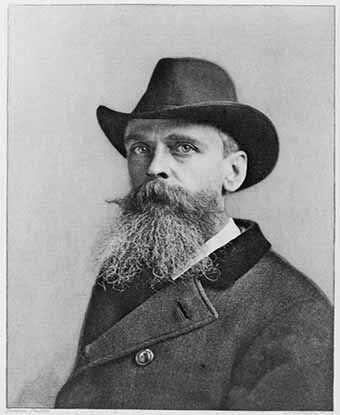

Thomas Moran
US
58
Artworks
1837 - 1926
Lifespan
Artist Biography
Thomas Moran (1837–1926) was a preeminent American painter of the Hudson River School, whose epic landscapes of the American West were instrumental in shaping the nation’s perception of its own wilderness. Born in Bolton, Lancashire, England, Moran immigrated with his family to the United States in 1844, settling in Philadelphia. His artistic journey began as a teenage apprentice at the wood-engraving firm Scattergood & Telfer. Finding the process tedious, he dedicated his free time to watercolors and illustrations, supported by his older brother, the marine artist Edward Moran. This early training in printmaking provided him with a technical foundation that would complement his painting throughout his career.
A formative influence on Moran was the work of the British master J.M.W. Turner. In 1862, Moran traveled to England specifically to study Turner's paintings at the National Gallery in London. He was profoundly affected by Turner's dramatic use of light, atmospheric effects, and sublime portrayal of nature. This experience solidified his artistic direction, steering him towards a Romantic style that captured both the grandeur and the emotional power of the landscape. Upon his return, Moran established himself as a chief illustrator for Scribner's Monthly, a position that honed his compositional skills and provided a platform for his burgeoning talent.
The pivotal moment of Moran's career arrived in 1871 when he was invited to join Ferdinand V. Hayden's geological survey expedition to the then-unknown Yellowstone region. As the expedition's official artist, Moran, alongside photographer William Henry Jackson, was tasked with documenting the area's geological wonders. His vibrant watercolors and dramatic sketches of geysers, canyons, and waterfalls captivated the American public and, crucially, the members of Congress. The visual evidence presented by Moran and Jackson was so compelling that it directly led to the establishment of Yellowstone as the world's first national park in 1872. This achievement secured Moran's fame, and he famously adopted the signature T-Y-M (Thomas "Yellowstone" Moran).
Following his success, Moran became a leading figure of the Rocky Mountain School, a group of artists who applied the aesthetic of the Hudson River School to the more rugged and vast terrains of the West. His monumental canvases, such as "The Grand Canyon of the Yellowstone" (1872) and "The Chasm of the Colorado" (1873–74), were purchased by the U.S. government for display in the Capitol, cementing his status as a national artist. These works exemplify the concept of the Sublime, where nature's immense power inspires both awe and a sense of terror, dwarfing human scale. His ability to render these spectacles with both geological accuracy and divine grandeur is often seen as surpassing his contemporaries.
Moran continued to travel and paint extensively throughout his long life. He journeyed to the Grand Canyon, Utah's Zion Canyon, and Colorado, and also made trips to Venice, Florida, and Mexico, always seeking grand natural subjects. He and his wife, Mary Nimmo Moran, an accomplished artist herself, were also key figures in the American Etching Revival. Moran’s legacy is complex; his work helped popularize the West, encouraging tourism, but it was also fundamental to the conservation movement. Dying in 1926 in Santa Barbara, California, he was mourned as the "Dean of American Painters," leaving behind a body of work that defined the American landscape for generations and continues to inspire awe for the nation's natural wonders.